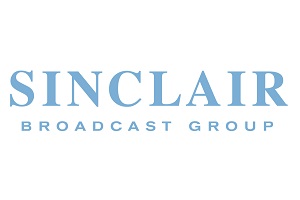Sinclair to build NextGen data distribution core network to support multiple new revenue-producing use cases

Sinclair Broadcast Group, Inc. has announced that it will build and operate an interconnected broadcast platform to provide commercial services and solutions for national data distribution. Using NextGen Broadcast (ATSC 3.0) network technology, this platform is designed to provide a wireless broadcast backbone for IP (Internet Protocol) data delivery across the country, increasing the value of spectrum for all broadcasters and providing an IP connection to serve their communities better.
As a distribution industry, U.S. broadcasters, including commercial and non-commercial station operators, have deployed NextGen Broadcast service to date across the U.S. in 69 markets covering over 60% of the country’s population. Many more deployments are on schedule for this year. Linking those markets and stations to allocate data capacity efficiently among potential data customers is essential in establishing broadcasting as a competitive data distribution platform. That is the purpose of this Core Network.
In anticipation of providing a Data Distribution as a Service (DDaaS) platform, Sinclair established several joint ventures and strategic relationships with some key technology partners in the U.S., Korea and India. Working with Sinclair, these partners are designing, building and deploying this sophisticated DDaaS platform infrastructure. Those relationships include CAST.ERA, a joint venture with SK Telecom, a South Korean Information Communications Technology company, which brings its sophisticated experience to infrastructure development. SK Telecom will be providing its advanced mobile edge computing technology, “Petasus Media,” to the project. Sinclair will also rely on Saankhya Labs in India, which will contribute to the broadcast Core Network and provide wireless technology to the new DDaaS platform.
Designed and built to exploit the efficient “one-to-many” architecture of broadcasting, this NextGen IP data platform will serve many diverse use cases. Those will include large-scale software updates for “edge-heavy” industries like Building/Industrial Automation, Automotive, and Critical Infrastructure. Data can be accurately and seamlessly distributed across diverse local/regional/national markets and delivered via broadcast spectrum using low-band channels, propagating further and penetrating buildings better than other wireless bands.
Data distribution companies or Content Distribution Networks (CDNs) seeking a cost-efficient supplement to perform data off-loading from traditional unicast cellular service will find this data distribution platform to be a needed complement to their IP data distribution tools. Spectrum providers, such as BitPath, will be able to utilise the DDaaS platform to monetise their spectrum in a way that is not currently possible in today’s decentralised and unconnected TV broadcast architecture.
As an example, providers of data services to vehicles will be able to deliver software updates simultaneously to an infinite number of IoT devices in their smart vehicles to update software for new functionality, infotainment, bug fixes, and navigation. Safety updates can be delivered within hours, not days. Services can be provided to hundreds of thousands of devices instantly and simultaneously with no slowdowns since broadcast architecture is not subject to cell phone network bottlenecks.
Notably, the platform is designed to enhance Advanced Emergency Information significantly by enabling region-wide connectivity for this critical public interest service that can provide connectivity where other communications systems may fail, especially during peak traffic times or in an emergency.
Last year’s Florida hurricanes are critical examples of the broadcast infrastructure. While over 2/3 of the cell phone network failed in and around Fort Myers during the category 4 Hurricane Ian (over 1,550 towers down), area-wide broadcast coverage remained in service. Of the 32 TV stations serving the Tampa market and another 14 in Fort Myers, only 5 suffered temporary outage. All the remaining television broadcasters blanketed the area. Interconnecting these TV broadcasters using a data network will ensure that users with charged cellphones and vehicles equipped with NextGen reception capabilities will have access to evacuation routes, shelter locations, and emergency resource locations, all of which can be conveyed in multiple languages. NextGen Broadcast can save lives. This DDaaS network is intended to facilitate these critical services.
The sophisticated NextGen wireless backbone will incorporate new cloud technologies including SD-WAN (Software Defined Wide Area Network) and AI (Artificial Intelligence) orchestration. This will permit cooperating broadcasters to match available spectrum capacity dynamically with users’ data needs. This platform is also designed to allow customers’ data to be tracked, confirmed, and billed in an effective ‘least cost routing’ manner. This IP-centric platform will deliver committed bit rates 24/7 with no slowdowns regardless of usage. The backbone network will also provide a wide range of security, modulation, and coding options catering to specific applications and quality of service needs. This data platform can scale across various spectrum-enabled businesses including automotive services, aircraft/drone connectivity, first responder missions, distance learning solutions, and more.
As NextGen Broadcasting is deployed throughout the country, and other broadcasters see the value in participating in this business, Sinclair expects use of the platform to increase from local and regional services available in some markets now to nationwide services by 2024. To this end, Sinclair has created a new DDaaS business-related unit under Del Parks, President of Technology, to capitalise on these emerging opportunities.
Chris Ripley, Sinclair’s president and CEO, says “Data Distribution as a Service is the inevitable next step in the evolution of broadcasting. It allows us to continue providing exceptional and enhanced video programming and, at the same time, repurpose the remaining capacity of our channels to meet the needs of data users nation-wide on market-disrupting terms. The service is part of our future. Building this platform is one of the necessary and exciting steps to that end.”
Comment on this article below or via Twitter @IoTGN
